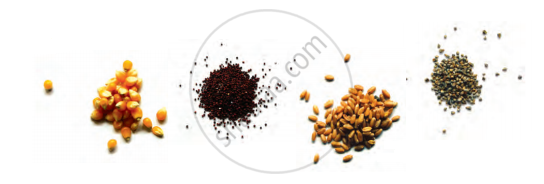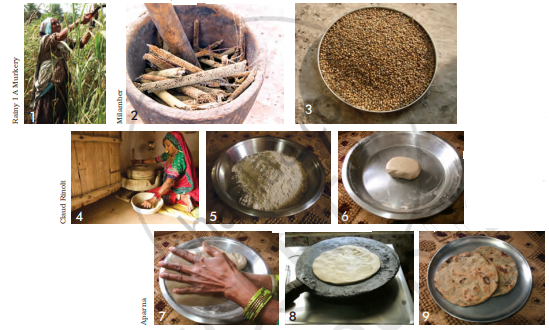Advertisements
Chapters
2: A Snake Charmer’s Story
3: From Tasting to Digesting
4: Mangoes Round the Year
5: Seeds and Seeds
6: Every Drop Counts
7: Experiments with Water
8: A Treat for Mosquitoes
9: Up You Go!
10: Walls Tell Stories
11: Sunita in Space
12: What if it Finishes ...?
13: A Shelter so High!
14: When the Earth Shook!
15: Blow Hot, Blow Cold
16: Who will do this Work?
17: Across the Wall
18: No Place for Us?
▶ 19: A Seed tells a Farmer’s Story
20: Whose Forests?
21: Like Father, Like Daughter
22: On the Move Again
![NCERT solutions for Environmental Studies - Looking Around [English] Class 5 chapter 19 - A Seed tells a Farmer’s Story NCERT solutions for Environmental Studies - Looking Around [English] Class 5 chapter 19 - A Seed tells a Farmer’s Story - Shaalaa.com](/images/environmental-studies-looking-around-english-class-5_6:71bdf81a5f57474cb6fe25f9506ae503.jpg)
Advertisements
Solutions for Chapter 19: A Seed tells a Farmer’s Story
Below listed, you can find solutions for Chapter 19 of CBSE NCERT for Environmental Studies - Looking Around [English] Class 5.
NCERT solutions for Environmental Studies - Looking Around [English] Class 5 19 A Seed tells a Farmer’s Story A Seed tells a Farmer’s Story [Pages 175 - 181]
Tell
Are rotis made in your home? From which grains are they made?
Have you eaten roti made from bajra or jowar? Did you like these?
Find out and write
In your house what is done to protect grains and pulses from insects?
Which are the different festivals related to farming, celebrated in different seasons? Find out more about anyone such festival and write in your notebook –
The name of the festival, in which season is it celebrated, in which states of India, what special foods are made, is it celebrated only at home with the family, or together with many people.
Talk to the elders in your family and find out if there were some special foods cooked earlier that are not cooked anymore?
Find out about the crops - cereals, vegetables, pulses - that are grown in your area. Of those, is there anything that is famous across the country?
Can you recognize these grains?

Discuss
The bajra seed saw differences in the way Damjibhai and Hasmukh did farming (for example, in irrigation, ploughing, etc). What were these differences?
Hasmukh said, “With profits from our fields, we can progress.” What is your understanding of ‘progress’?
Write
What kind of progress would you like to see in your area?
Discuss and think
What can happen to Hasmukh’s farm after some years?
Damjibhai’s son Hasmukh chose to become a farmer like his father. Hasmukh’s son Paresh is not a farmer, but a truck driver. Why would he have done so?
The seeds were not sure that what Hasmukh was talking about was really progress. What do you feel?
Have there been any changes near your area, which may be difficult to call ‘progress’? What changes are these? What are the different opinions about them?
Project Work
What questions come to your mind about farmers and farming? Write some questions in your group and ask a farmer. For example, how many crops do they grow in a year? Which crop needs how much water?
Visit a farm near your area. Observe and talk to the people there. Write a report.
Journey of a bajra seed – from a field to a plate
What can you see in each picture on the next page?
In picture 2 you can see the bajra cobs in the mortar (okhli, used for crushing). The cobs are crushed with a pestle (moosli) and the seeds are separated from the cob. You can see the separated seeds in picture 3. Now this work is also done by big machines, like threshers. We call both these different ‘technologies’ – using our hands or big machines – to crush the seeds.
What technology could have been used to cut the stem in picture 1? What do you think is being done in the grinder (chakki ) in picture 4? What ways (technologies) would have been used to do the work shown in pictures 5 and 6? You can see that the dough is ready in picture 6. When do you think a sieve (chhalni ) would have been used? Discuss each step in detail, in any language you wish to use.

What we have learnt
There have been many changes over time, in our food. What can this mean? Use the seed story and what you know from your elders to explain.
What would happen if all the farmers were to use only one kind of seed and grow only one kind of crop?
Solutions for 19: A Seed tells a Farmer’s Story
![NCERT solutions for Environmental Studies - Looking Around [English] Class 5 chapter 19 - A Seed tells a Farmer’s Story NCERT solutions for Environmental Studies - Looking Around [English] Class 5 chapter 19 - A Seed tells a Farmer’s Story - Shaalaa.com](/images/environmental-studies-looking-around-english-class-5_6:71bdf81a5f57474cb6fe25f9506ae503.jpg)
NCERT solutions for Environmental Studies - Looking Around [English] Class 5 chapter 19 - A Seed tells a Farmer’s Story
Shaalaa.com has the CBSE Mathematics Environmental Studies - Looking Around [English] Class 5 CBSE solutions in a manner that help students grasp basic concepts better and faster. The detailed, step-by-step solutions will help you understand the concepts better and clarify any confusion. NCERT solutions for Mathematics Environmental Studies - Looking Around [English] Class 5 CBSE 19 (A Seed tells a Farmer’s Story) include all questions with answers and detailed explanations. This will clear students' doubts about questions and improve their application skills while preparing for board exams.
Further, we at Shaalaa.com provide such solutions so students can prepare for written exams. NCERT textbook solutions can be a core help for self-study and provide excellent self-help guidance for students.
Concepts covered in Environmental Studies - Looking Around [English] Class 5 chapter 19 A Seed tells a Farmer’s Story are A Seed Tells a Farmer’s Story.
Using NCERT Environmental Studies - Looking Around [English] Class 5 solutions A Seed tells a Farmer’s Story exercise by students is an easy way to prepare for the exams, as they involve solutions arranged chapter-wise and also page-wise. The questions involved in NCERT Solutions are essential questions that can be asked in the final exam. Maximum CBSE Environmental Studies - Looking Around [English] Class 5 students prefer NCERT Textbook Solutions to score more in exams.
Get the free view of Chapter 19, A Seed tells a Farmer’s Story Environmental Studies - Looking Around [English] Class 5 additional questions for Mathematics Environmental Studies - Looking Around [English] Class 5 CBSE, and you can use Shaalaa.com to keep it handy for your exam preparation.
